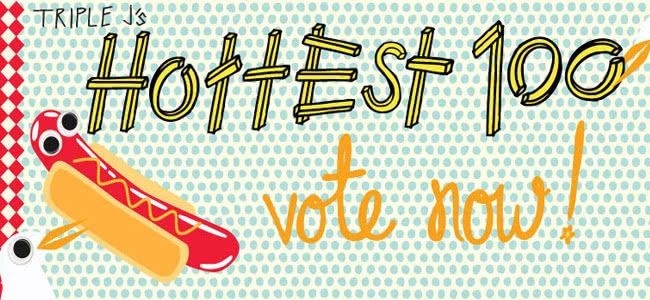Nick Drewe and Tom Knox, the two young Brisbane-based IT experts who managed to use social media algorithms to crack Triple J’s Hottest 100, have become internet folk heroes to some and slightly villainous spoilers alike since their analysis of around 35,000 Hottest 100 votes submitted to Facebook, Twitter, and Pinterest towards the world’s largest annual music poll resulted in the Warmest 100.
The pair of developers have now discussed the impact of their chart, talking about the inner workings of their predictive list in an interview on ABC Radio National’s Download This Show podcast.
On the broadcast (which you can listen to in full below), Nick Drewe discusses how he came upon the idea of tracking the social media submissions, before reaching out to “a few friends and one of them was Tom Knox and he had a great idea to put the website together.”
“At the time we thought we had around a 2-2.7% sample of what the total vote would be based on the 2011 voting numbers,” says Drewe. “It probably turned out to be a little less than that this year since Triple J had record voting numbers for the Hottest 100 2012.”
When he was shown the tracked stats, Knox tells the podcast that his initial response was “let’s see how much money we can make.” Which was, as it turns out, “none, we’ve spent about $50 and a lot of time, domain registration and a week of all of our lives.”
Questioned whether the pair were concerned about people’s reactions over having their Australia Day plans (and bets) potentially spoiled, Knox replies, ” Yeah, we were. Nick and I bounced around ideas about what would happen if we published this and made sure that we tried to do it in such a way that wouldn’t piss anyone off.”“Our concern from the outset and the whole way through was to make this as Triple J fan friendly as possible.” – Nick Drewe
Which included placing a bold disclaimer as the first thing users saw when visiting the Warmest 100 website, with warnings dotted throughout the flashy countdown on the website (the preamble before the Top 10 reading “Maaate, Really? We Don’t Want To Spoil Your Australia Day!”).
“Our concern from the outset and the whole way through was to make this as Triple J fan friendly as possible,” explains Drewe. “We never wanted to spoil the countdown for anyone, and we never wanted to, you know, ruffle too many feathers.” Adding that in their defence, “all sorts of blogs and industry blogs put out their predictions every year. Ours was just a little more informed using that social data.”
Once the website was live and ready, Drewe and Knox’s duties didn’t wind up. “Australia Day for me was pretty much sitting around on my iPad tweeting out each song as it came off and updating a live spreadsheet,” says Drewe.
As well as “responding to feedback” over the “hate [that started] coming in after the first 10 songs and everyone realised we weren’t going to be spot on. But as the day progressed they were getting a lot more accurate as the list moved up and up towards number one.”
In fact, the pair eventually forecast 92 of the 100 songs on the final chart, and the Brisbane duo’s stats even nailed five rankings in the Top 10 correctly, including the Top 3 positions (as this handy graph demonstrates). Some impressively accurate results considering the duo’s sample accounted for roughly 2.7% of the total entries submitted to the 2012 poll, analysing just 35,081 votes from 3,602 entires.
It was a little too close for comfort the ABC announced they’d consider making changes to the Hottest 100 voting system. Perhaps influenced by the mix of controversy and the IT wiz’s own Warmest 100, Triple J then aired the 101-200 results (for the first time ever) on the national youth radio station the weekend after Macklemore & Ryan Lewis ‘Thrift Shop’ topped the Hottest 100.“They’re (the ABC) certainly welcome to hire us to consult on it if they want.” – Nick Drewe
The first time a hip hop song achieved such a feat in the Hottest 100′s nearly 30 year history (but not the first time a novelty tune has, here’s looking at you ‘Pretty Fly For A White Guy’), which was also accurately predicted by Drewe and Knox’s Warmest 100 chart.
So what should Triple J do to prevent future predictions? The Warmest 100 team have a few ideas.
“You might be able to use some sort of random collage of cover art to display what you’ve voted for,” Drewe suggests as just one of a few ideas he and his cohort have “tossed about,”
“The reason we were able to get all the votes off the pages was that they were on there in plain text, which is as easy as a copy and paste, to put it into a spreadsheet,” he adds, but using visuals, or iconography, would make it “a lot harder for someone to match up songs.”
Drewe also suggests that building a closer guarded Facebook app, which has inherently tighter security that Twitter and Pinterest, as “a a way to keep the votes a lot tighter to their chest.” It’s an idea “that the ABC might be particularly interested in,” cheekily adding “they’re certainly welcome to hire us to consult on it if they want.”
As for what’s next for the pair following their social experiment? Drewe says he plans to dig deeper into “the number side of things” with the Warmest 100 demonstrating to the developer that social media continues to emerge as a developing statistical pool. “People are sharing more and more about themselves publicly online and there’s lots of different and interesting ways that we can use that,” says Drewe. “[To] process and look at that data and turn it into interesting things like the Warmest 100”

































